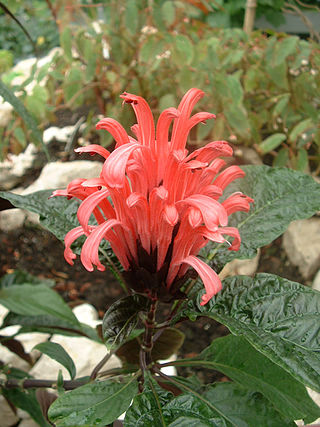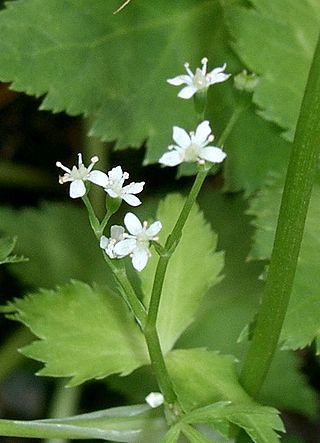
Honeysuckles are arching shrubs or twining vines in the genus Lonicera of the family Caprifoliaceae, native to northern latitudes in North America and Eurasia. Approximately 180 species of honeysuckle have been identified in both continents. Widely known species include Lonicera periclymenum, Lonicera japonica and Lonicera sempervirens. L. japonica is a highly invasive species considered a significant pest in parts of North America, Europe, South America, Australia, and Africa.

Cryptomeria is a monotypic genus of conifer in the cypress family Cupressaceae. It includes only one species, Cryptomeria japonica. It used to be considered by some to be endemic to Japan, where it is known as Sugi. The tree is called Japanese cedar or Japanese redwood in English. It has been extensively introduced and cultivated for wood production on the Azores.

Lonicera japonica, known as Japanese honeysuckle and golden-and-silver honeysuckle, is a species of honeysuckle native to East Asia, including many parts of China. It is often grown as an ornamental plant, but has become an invasive species in a number of countries. Japanese honeysuckle is used in traditional Chinese medicine.

The loquat, called biwa in Japan, is a large evergreen shrub or tree grown commercially for its orange fruit and for its leaves, which are used to make herbal tea. It is also cultivated as an ornamental plant.

Justicia is a genus of flowering plants in the family Acanthaceae. It is the largest genus within the family, encompassing around 700 species with hundreds more as yet unresolved. They are native to tropical to warm temperate regions of the Americas, India, and Africa. The genus serves as host to many butterfly species, such as Anartia fatima. Common names include water-willow and shrimp plant, the latter from the inflorescences, which resemble a shrimp in some species. The generic name honours Scottish horticulturist James Justice (1698–1763). They are closely related to Pachystachys.

Camellia japonica, known as common camellia, or Japanese camellia, is a species of Camellia, a flowering plant genus in the family Theaceae. There are thousands of cultivars of C. japonica in cultivation, with many colors and forms of flowers. Despite its common name, it is native to China, not Japan. The cultivation of Camellia japonica also started in China. Its widespread cultivation can be traced back to the Song Dynasty, when 15 varieties of Camellia japonica were recorded in literature. It was later introduced to Japan. It grows in forests, at altitudes of around 300–1,100 metres (980–3,600 ft).

Cryptotaenia japonica, also called East Asian wildparsley, Japanese cryptotaenia, Japanese honewort, white chervilmitsuba, Japanese wild parsley, stone parsley, honeywort, san ip, trefoil, and san ye qin is a plant species native to Japan, Korea, and China. The plant is edible and is commonly used as a garnish and root vegetable in Japan, and other Asian countries.

Julio Andrés Borges Junyent is a Venezuelan politician and lawyer. In the late 1990s he had a TV court show called "Justicia Para Todos" on Radio Caracas Televisión. He co-founded the party Primero Justicia in 2000 together with Henrique Capriles Radonski and Leopoldo Lopez.

Ulmus davidiana var. japonica, the Japanese elm, is one of the larger and more graceful Asiatic elms, endemic to much of continental northeast Asia and Japan, where it grows in swamp forest on young alluvial soils, although much of this habitat has now been lost to intensive rice cultivation.

Club Social y Deportivo Defensa y Justicia, commonly known as Defensa y Justicia, is an Argentine football club from Florencio Varela, Buenos Aires, established in 1935. The senior squad currently plays in the Primera División, the top division of the Argentine football league system.

SS Justicia was a British troop ship that was launched in Ireland in 1914 and sunk off County Donegal in 1918. She was designed and launched as the transatlantic liner Statendam, a new flagship for the Holland America Line (NASM), but the outbreak of First World War delayed her completion. In 1915 NASM agreed to let the United Kingdom acquire her and have her completed as a troop ship.

Udea rubigalis, the celery leaftier or greenhouse leaftier, is a member of the family Crambidae. It is found across the Americas. The species was first described by Achille Guenée in 1854.

Japonica rice, sometimes called sinica rice, is one of the two major domestic types of Asian rice varieties. Japonica rice is extensively cultivated and consumed in East Asia, whereas in most other regions indica rice is the dominant type of rice. Japonica rice originated from Central China, where it was first domesticated along the Yangtze River basin approximately 9,500 to 6,000 years ago.
Rickettsia japonica is a species of Rickettsia. It can cause Japanese spotted fever.
J. japonica may refer to:

Teniloxazine, also known as sufoxazine and sulfoxazine, is a drug which is marketed in Japan. Though initially investigated as a neuroprotective and nootropic agent for the treatment of cerebrovascular insufficiency in the 1980s, it was ultimately developed and approved as an antidepressant instead. It acts as a potent norepinephrine reuptake inhibitor, with fair selectivity over the serotonin and dopamine transporters, and also behaves as an antagonist of the 5-HT2A receptor.
The Supreme Court of Justice is the highest court of ordinary jurisdiction in Bolivia, based in Sucre. Its powers are set out in Articles 181–185 of the 2009 Constitution and the Law of the Judicial Organ. It was first seated on 2 January 2012.

The Ministry of Justice of Argentina is a ministry of the national executive power tasked with enforcing of the law and administration of justice.
The hybrid elm Ulmus davidianavar.japonica × U. minor was raised at the Arnold Arboretum before 1924.















